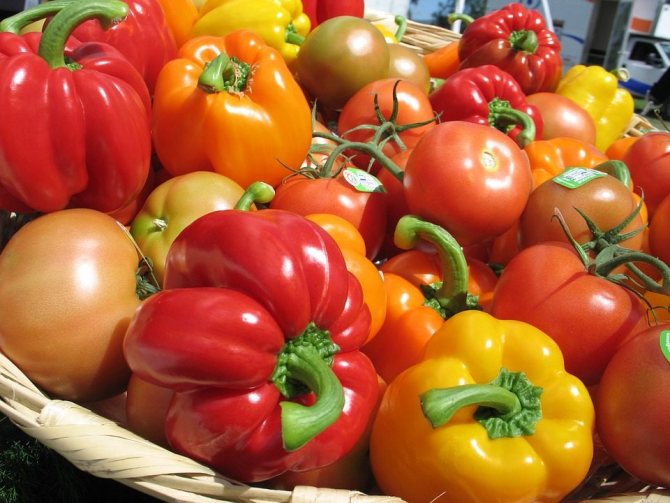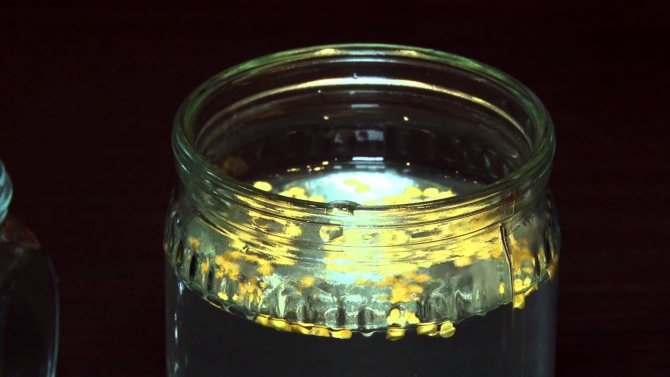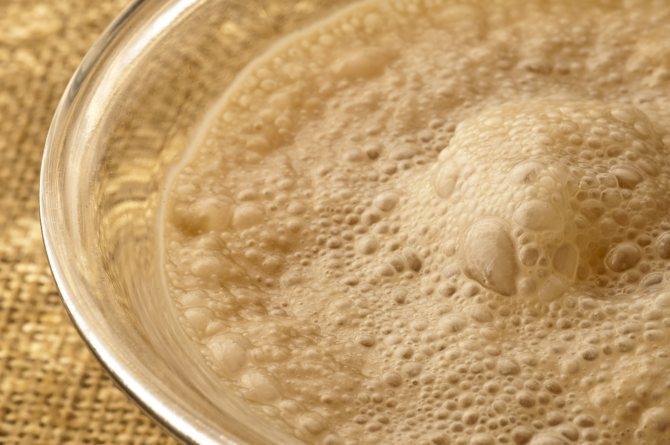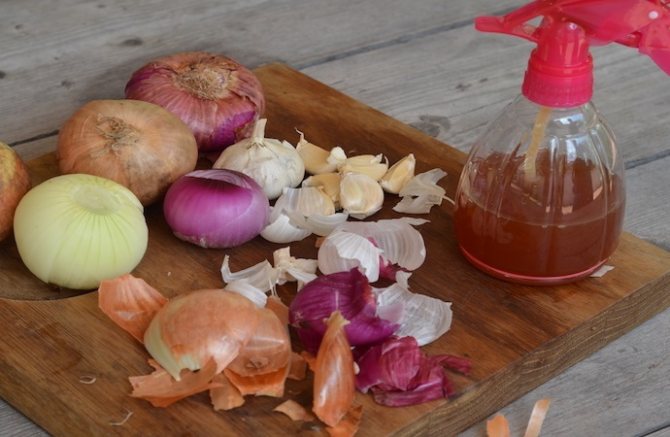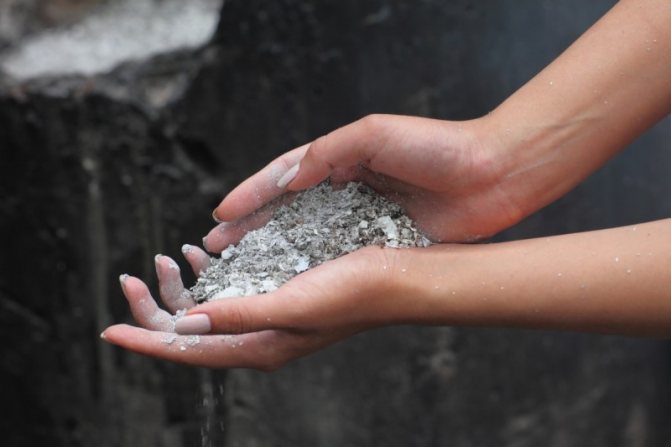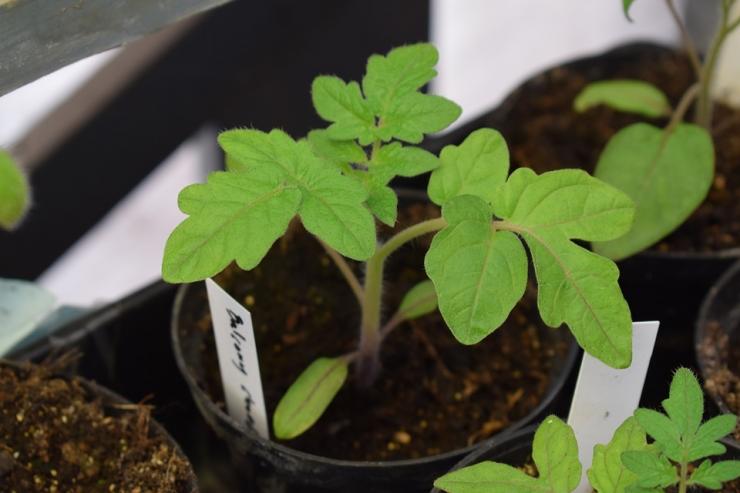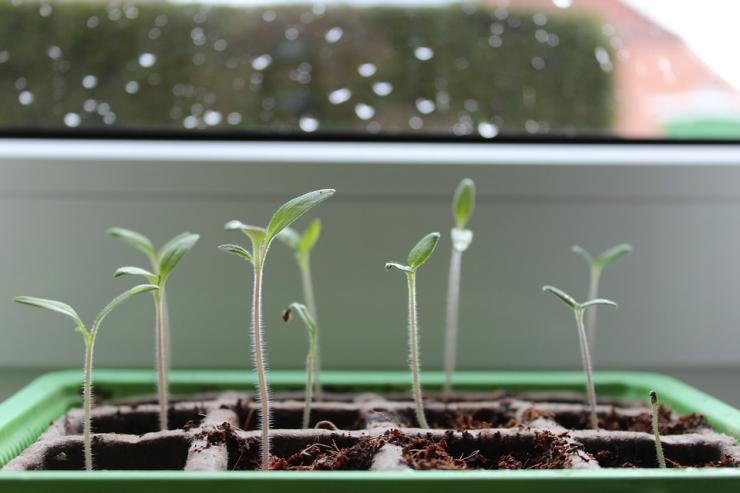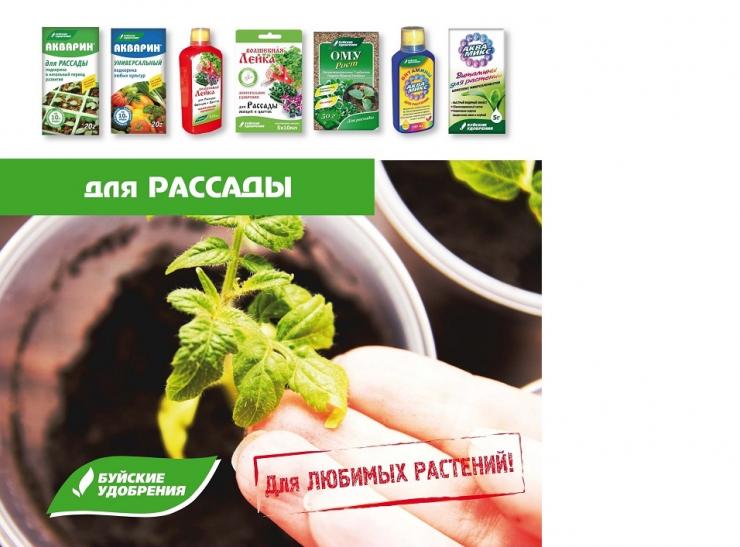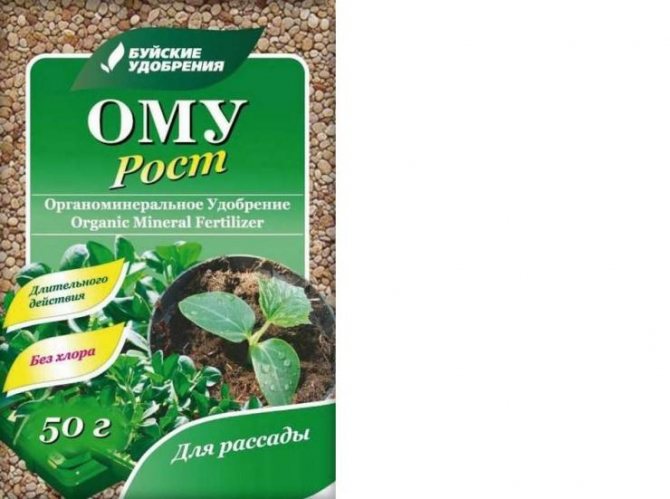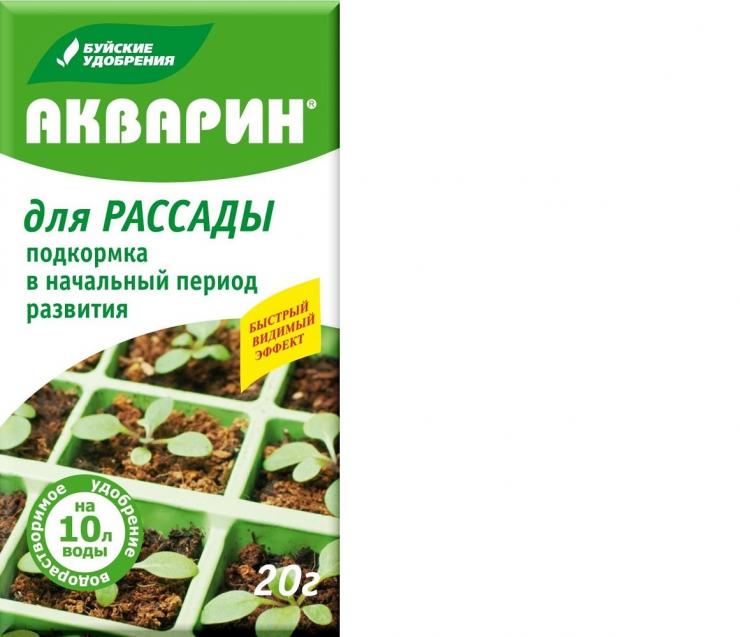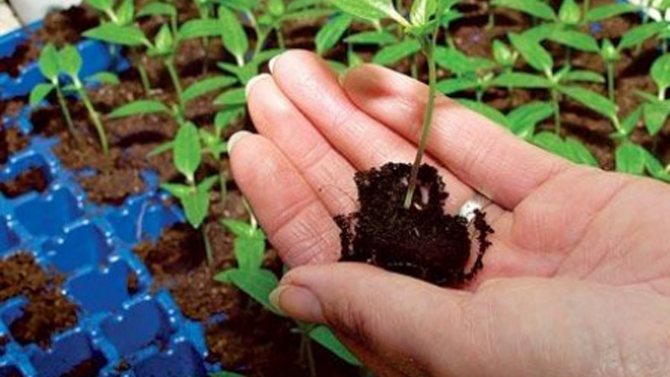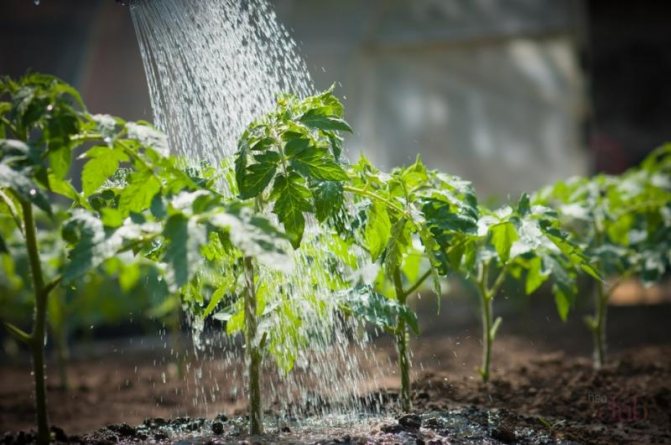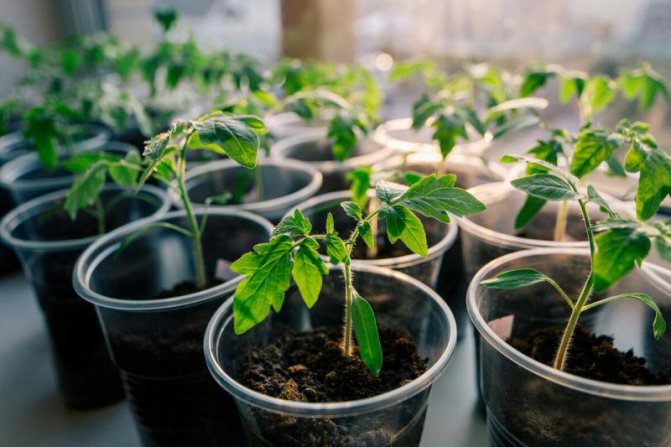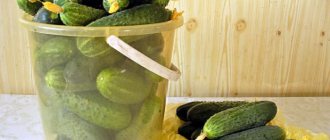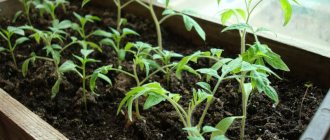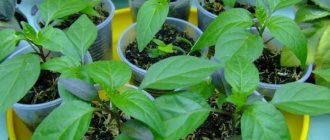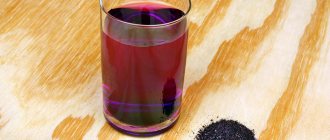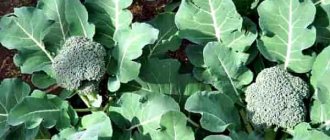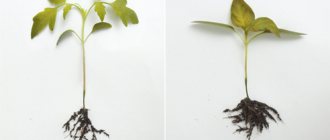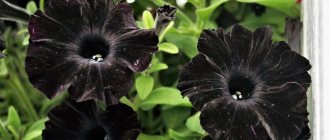Top dressing of tomato and pepper seedlings with folk remedies
Today, in horticultural stores, you can buy many different preparations for feeding seedlings. But, for lovers of everything natural, the best option for such fertilizers will be those that are made by hand.
The main substances required for peppers and tomatoes are potassium, nitrogen and phosphorus. The best nitrogen source for these vegetable crops is poultry manure. It must be diluted with water in a ratio of one to two and left for 2-3 days. The resulting concentrate must be mixed and added to the water for irrigation (1:10). Poultry droppings can accelerate the growth of tops. But, it can be used only once before moving the nightshade to open ground.
Coffee drinkers often have a lot of waste grounds left over. It can be used not only as a substrate for growing mushrooms, but also as a source of nutrition for seedlings. In addition to the main action, coffee grounds loosens the soil well and improves oxygen access to plant roots. In order to improve the structure of the soil, it is enough just to add a little coffee grounds to it.
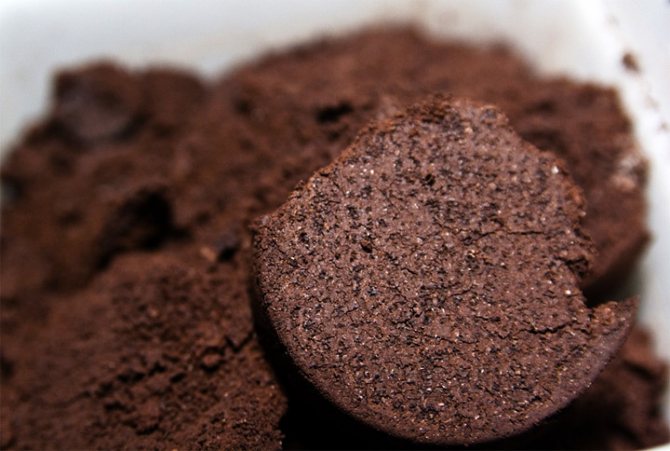
Coffee waste to improve the substrate
Another type of "folk" feeding is onion peel. It (20 g) is poured with water (5 liters) and left for 3-4 days. Then the water can be used to water the seedlings. She will not only fill the soil with useful substances, but also be able to disinfect it.
Also, in this capacity, you can use the water in which potatoes, beet sugar and dry yeast were cooked.
One-stop solutions
There are a wide variety of dressings that can be used for both tomato and pepper. The optimal solution is ash fertilization. To do this, you need to take 1 tbsp. l. substance and dilute it in 2 liters of water. Leave the solution for 24 hours, then strain. To enrich the seedlings with more potassium, banana peels can be used to heal the soil. For this reason, summer residents do not throw away the skins from the fruit, but make effective feeding out of them. It is necessary to dry the peel on a battery, then grind it into powder and add it to the soil when planting a tomato. Alternatively, the skins can be steeped in water (2-3 banana peels in a three-liter jar). The drug should stand for 4 days, after which it should be filtered and watering the seedlings twice a day.
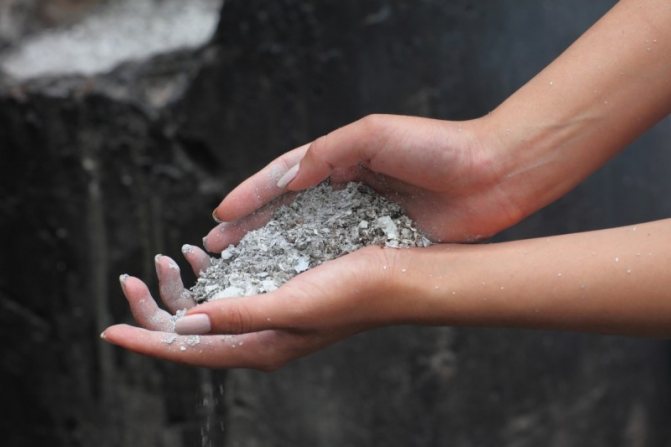

An excellent folk remedy is an egg shell infusion. Such a preparation is a real storehouse of macro- and microelements. To prepare a useful substance, you need to take 3 liters of cold water and add crushed shells from 4-5 eggs to it. It is necessary to insist feeding for 72 hours under a lid. When the fertilizer is ready, the liquid will become cloudy and have a specific odor. In addition, some summer residents simply sprinkle the shells in the greenhouse - this will help the peppers and tomatoes germinate faster.
You can prepare effective top dressing with the help of food products that can be found in the house of every summer resident:
- 1. Fertilizer from coffee grounds. To make the remedy, you need to dry the used brewed coffee and then mix it with the soil before planting the seedlings in the greenhouse.The drug improves the water permeability of the soil, and also loosens it qualitatively. Together with top dressing, important trace elements, including nitrogen, enter the soil. Note that the fertilizer is suitable not only for tomatoes and peppers, but also for eggplants or cucumbers.
- 2. Onion husks. Top dressing is prepared from 20 g of husk and 5 liters of warm water. It is necessary to insist the solution for 4 days, after which the liquid is filtered and used as fertilizer in the ground or for spraying seedlings. Thanks to the tool, pest prevention can be carried out.
- 3. Potato husk and peel. Root fertilizer contains large amounts of starch. To prepare the product, you need to take the cleaning, boil it, grind it into a gruel and spread it into the soil under each bush.
- 4. The use of sugar. Plants are terrible "sweet tooth", so it is necessary to pamper tomatoes and peppers with sweet syrup once every 7 days. To liven up vegetables, you need to dilute 2 tsp. sugar in 1 glass of water and water the plants abundantly. Alternatively, you can sprinkle 1 tsp. sugar along the bushes.
Fertilizers for tomato and pepper seedlings can be made from aloe juice. It is very simple to prepare the solution. This will require 1 liter of water and 3-4 tsp. freshly squeezed juice. The resulting top dressing is an excellent growth stimulator. Alternatively, you can fertilize your vegetables with citrus peels that are ground into powder and added to the soil at the time of planting. You can also feed peppers and tomatoes with a solution of toothpaste: dilute 1/3 of the tube in 1 liter of water at room temperature.
An infusion of herbs can also be used as an effective top dressing: weeds, nettles and kitchen waste are poured with warm water. The drug is left for 7-12 days, after which 10-15 g of mullein or chicken droppings are added. The liquid is applied to the soil, applying under each bush. Experienced summer residents recommend keeping a bucket of solution in a greenhouse, since carbon dioxide is released during fermentation, which will have a good effect on plants.
To fertilize peppers and tomatoes, you can buy ordinary brilliant green: dissolve 40 g of brilliant green in a bucket of water and pour the vegetable bushes with liquid. For similar purposes, potassium permanganate can also be used (for 3 g, you need to take 10 liters of water).
If you know how and what to fertilize tomato and pepper seedlings, you can get a good, plentiful harvest of vegetables.
Banana peel dressing for tomato and pepper seedlings
If you have banana skins in large quantities, they can be used to eliminate potassium deficiency in plants. The lack of this element negatively affects the absorption of nitrogen. Which leads to sluggish and weak seedlings.
Preparing "banana" feed is very simple. It is necessary to place 3-4 banana skins in a three-liter jar, fill them with water and insist for 3 days. After this time, potassium will be released from the skins and will fill the water. Which then you need to water the plants.
Fertilizers for seedlings of tomatoes and peppers
The introduction of nutrients into the soil is an important step on the way to a large harvest of vegetables. But, if the substrate in which the seedlings of these nightshade crops are grown is rich in nutritive compounds, then it is better to refuse such feeding. After all, an excess of them affects plants worse than a deficit.
For example, excess nitrogen accelerates plant growth but does not increase yield. Therefore, it is necessary to feed these plants only when their appearance tells us about it.
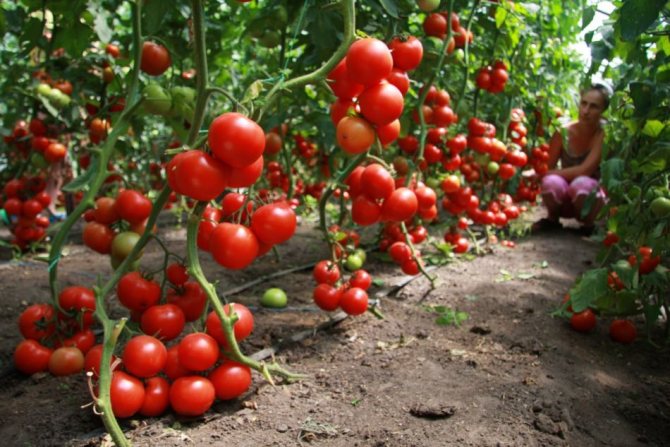

A bountiful harvest
It is best to use a solution of rotted manure or special mineral fertilizers at this time.
- Superphosphate (3 g), potassium (1 g) and ammonium nitrate (0.5 g) are diluted in separated water (1 liter)
For tomatoes, it is best to use a solution like this:
- Urea (0.5 g), superphosphate (4 g) and potassium salt (1.5 g) are diluted in one liter of water
Also, you can use the formulations that are described in the first section of this article.
What fertilizers and when to feed tomatoes after transplanting?
In order for the seedlings to be plump, and the fruits to be large, the correct selection of the composition for feeding is necessary. Also, regularity and the correct scheme of procedures are important. It is advisable to alternate root dressing with foliar fertilization. In addition, the rules for conducting procedures should be followed.
Root preparations
The first feeding should be applied no earlier than 10-14 days after the pick... The second top dressing is applied in two weeks. The third - as needed. The last feeding of seedlings is carried out 10 days before planting the plants in the ground.
After picking, the plant actively builds up its green mass, and the following compositions will help in this.
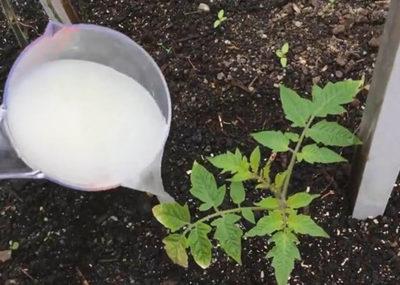

Recipe number 1:
- 1 tbsp. spoon of urea.
- 1 liter of water.
Mix the components until completely dissolved and water the plants abundantly. Such feeding contributes to the growth of green mass.
Recipe number 2:
- 1 liter of water.
- 1 tbsp. spoon of fertilizer "Nitrofoska".
Stir the ingredients until completely dissolved and water the seedlings abundantly.
"Nitrofoska" is a mineral fertilizer. The main components are phosphorus, potassium, nitrogen in equal proportions. Available in the form of granules.
You can learn more about the benefits of mineral fertilizers for seedlings and adult tomatoes, as well as the types of fertilizing and their application, here.
Recipe number 3:
- 1 teaspoon of potassium sulfate.
- 1 tbsp. spoon of superphosphate.
- 0.5 liters of chicken manure.
- Water -10 l.
Recipe number 4:
- 0.5 liters of liquid mullein.
- 1 tbsp. spoon "Nitrofoski".
- 10 liters of water.
Liquid mullein can be purchased at any gardening store. It is usually sold in 5L containers. According to the manufacturer's information, 1 liter of such liquid replaces 100 kg of fresh manure. You can also buy dry mullein in various packages at the garden store.
Fertilizers according to recipes 3 and 4 should be added under each bush 200-300 g (about half of a 0.5-liter can).
Foliar spray formulations
Foliar dressing is spraying plants with special formulations from a spray bottle... It is a great way to fertilize plants during active growth stages and soil problems.
The main plus is the rapid absorption of nutrients. The second advantage is efficiency in adverse weather conditions.


There is also a minus - the difficulty in selecting the concentration of the drug. If you exceed it, you can get burns on the leaves. In this case, the fertilizer concentration should be 3 times less than with root dressing.
When foliar dressings are shown:
- Too acidic soil. Root fertilizers in such soil are poorly absorbed.
- Plants have a weak appearance with pronounced signs of micronutrient deficiencies.
- Before flowering.
- For root problems, when the absorption of nutrients through the root is difficult. The reasons may be different: high soil temperature, waterlogging of the soil, lack of oxygen in the soil, damaged roots (during transplantation or due to pests).
Foliar dressing should not be carried out during the day, as the liquid from the leaves quickly evaporates and the effectiveness of the procedure is lost.
Consider the most effective recipes.
Recipe number 1:
- Water - 9 liters.
- 10 drops of iodine.
- 1 liter of milk whey.
Recipe number 2:
- ½ a small bottle of brilliant green (brilliant green).
- 10 pieces. tablets "Trichopol".
- 10 liters of water.
Recipe number 3:
- ½ cup sugar.
- Iodine 15 drops.
- 2 liters of milk whey.
- 10 liters of water.
Read more about the benefits of iodine for feeding tomatoes and how to use it correctly in this article.
Rules for foliar dressing:
- Foliar dressing is best done once every 10-14 days.
- Under no circumstances should the recommended concentration of substances in the preparation be exceeded.
- Daily monitor the condition of the plants, if it has worsened, then feeding should be either canceled or replaced with another drug.
- If the seedlings are in the greenhouse after spraying, the room must be ventilated (read about the main intricacies of fertilizing tomatoes in the greenhouse here, and from this article you will learn how to choose the best fertilizer for greenhouse seedlings).
- Spraying agents must be chlorine-free.
Read more about when to carry out foliar dressing and what drugs, read here.
Top dressing of tomato and pepper seedlings after picking
For the cultivation of high-quality planting material, feeding the seedlings after picking is of great importance. After this process, you need to add the necessary nutrients to the ground.
Baker's yeast showed itself very well at this stage of development of seedlings of these vegetable crops. They are rich in both nitrogen and phosphorus. But, yeast as a fertilizer has one, but significant disadvantage. During their life, these fungal microorganisms decompose potassium. To prevent this from happening, this mineral must be added to the yeast solution.
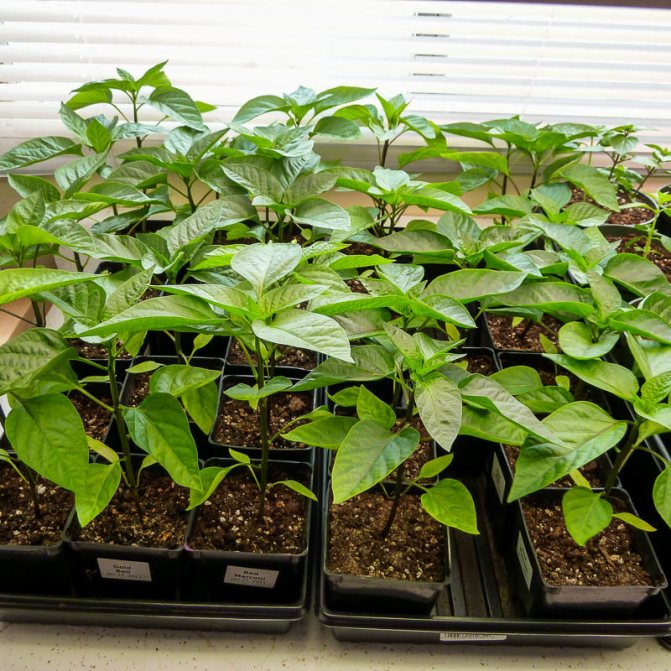

Seedling peppers
You need to fertilize the seedlings before watering. This is best done in the morning. After fertilization, the seedlings must be watered with water at room temperature.
When to feed seedlings
We take into account the composition of the soil mixture, since it is generally not recommended to feed the seedlings before the pick. There are enough nutrients in the soil for seedlings, and their excess in early spring with a lack of light will not lead to anything good. We do the first top dressing 2 weeks after the picking of the "transshipment" of the seedlings or when 2-4 true leaves appear (if the seedlings are grown without picking). Our further actions depend on the composition of the soil.


Self-prepared soil with the use of garden, leafy soil, humus and other nutrient components, it is not only fertile in itself, but also well retains salts dissolved in dressings, keeping them available to plants. Seedlings in such soil can be fed every 2 weeks.
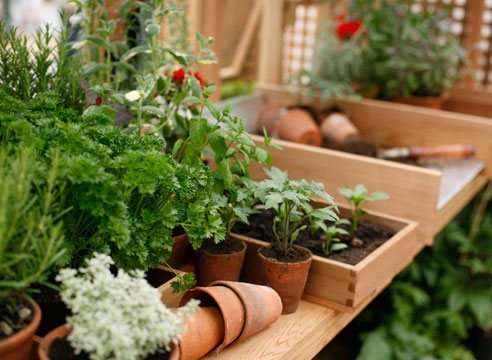

Purchased peat-based soil although it usually contains fertilizers, it places higher demands on the plant maintenance regime. The seedlings will have to be fed every week.
Seedling feeding rules:
- It is necessary to feed the seedlings, as well as to water, only in the morning, so that by the evening, when the temperature drops, the leaves and the soil surface have time to dry out. Cold and dripping moisture is an ideal environment for pathogenic fungi.
- If the soil in the pot is dry (the lump has lagged behind the walls, the pots are light and "ring" when tapped), the seedlings should be slightly watered before feeding and the moisture should be allowed to absorb well, and only then fed.
- If the soil is still slightly damp, the fertilizer solution is simply replaced with the irrigation water. For seedlings, only solutions of low concentration are taken, so preliminary thorough watering is not needed.
- For plants to assimilate nutrients well, oxygen must be available to the roots. From time to time, loosen the topsoil in the pots with a skewer or knitting needle, but not very deeply so as not to damage the roots. It is best to do this about an hour after watering.
The feeding rules do not obviate the need for observation. If you notice signs of starvation of seedlings, carry out an extra feeding. In this case, it is better to change the fertilizer, because it is not known whether the problem was caused by its imbalance.
Top dressing of tomato and pepper seedlings after planting in the ground
Peppers and tomatoes need subcrusting at all stages of plant development. But, if, while preparing the substrate for seedlings, it is easy to form a soil rich in nutrients, then it is somewhat more difficult to do the same with the beds.Therefore, the most optimal solution would be to apply fertilizers directly after plant transplantation.
But, the main thing here is not to overdo it. For this purpose, you should always look closely at the plants. If the summer is dry, then fertilizing with potassium not only will not give the expected result, but, on the contrary, can cause plant diseases.
But, if it rains quite often, then potassium in the soil may not be enough for seedlings and then you need to add this compound as a top dressing. But, this can be done only 15 days after transplanting the seedlings to a new place. This time is given so that the plants have time to adapt to new conditions.
After acclimatization of seedlings, they may need phosphorus-potassium supplements. But it is better to refuse nitrogen-containing dressings.
SECRET: When the peppers and tomatoes are blooming, dilute a small amount of sugar in water and sprinkle the beds with these plants on it. Sugar will attract bees, wasps and butterflies. These insects pollinate the plants and contribute to increased fruiting.
What peppers and tomatoes need
Experienced gardeners know how important nitrogen plays in the development of seedlings. The appearance of the plant depends on it: the thickness of the trunk, the saturation of the color and the juiciness of the leaves. Lack of nitrogen makes the seedlings thin, pale and vulnerable. But it is important to remember that excess nitrogen is bad for the yield of tomatoes and peppers. Phosphorus gives plants the energy to grow, promotes abundant flowering and proper fruit formation. Tomatoes are especially fond of him. Pepper needs more potassium, which is responsible for the development of the root system.
Fresh articles for gardeners, gardeners and florists
Treatment of trees in the spring from pests and diseases
Pruning trees in spring for beginners in pictures step by step
Spring processing of trees and shrubs from pests and diseases
Tomato picking in April 2020 according to the lunar calendar
You should not overdo it with fertilizing seedlings, even if folk remedies that do not contain harmful substances are used. Plants can get sick from an excess of valuable substances in the soil. It is very important to take into account the initial nutritional value of the soil. In some cases, there are enough minerals in the substrate used for seedlings to do without feeding at all. Important! Signs for the need to feed the seedlings can be such signs: discoloration, curling or drying of leaves, pallor, a thin long stem and a painful appearance of the plant. However, this can also happen due to seedling disease or lack of light, water, heat.
Feeding tomato and pepper seedlings with yeast
Fertilizing seedlings with yeast not only contributes to the introduction of nutrients into the soil, but also completely rebuilds the structure of the soil. This work of fungal microorganisms accelerates the growth of seedlings, and improves the yield of peppers and tomatoes.
The basis of such feeding is yeast (10 g), sugar (4 tablespoons) and water (10 liters). The resulting solution is a concentrate, which must be diluted with clean water in proportions of 1:10 before being applied to the soil.
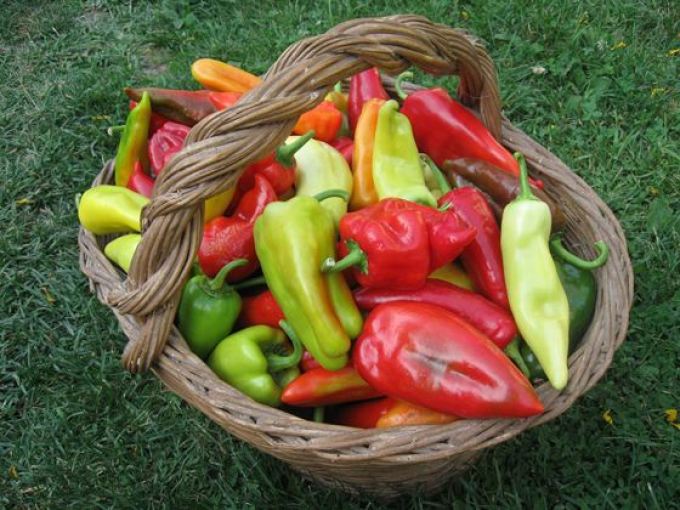

Rich harvest of peppers
You can replace yeast with wheat grains. To do this, they are poured with a small amount of water and left in a warm place. When the grains swell, they need to be ground into porridge and sugar added. Two to three tablespoons per glass of dry wheat grains. The resulting viscous mass must be heated and left for a day in a dark place.
Before using such a top dressing, this mass must also be diluted with clean water.
How to feed seedlings
Before proceeding with feeding, you need to familiarize yourself with the types into which any fertilizer for seedlings of tomatoes and peppers is divided:
- Organic. This includes all folk remedies: a solution of mullein, wood ash, chicken droppings, yeast mixture.Such fertilizers are made independently, do not require a lot of time, effort and finance, and have a large percentage of assimilation.
- Organomineral. Includes saline solutions and organic components.
- Mineral. Contains the full range of nutrients necessary for the normal full growth of seedlings.
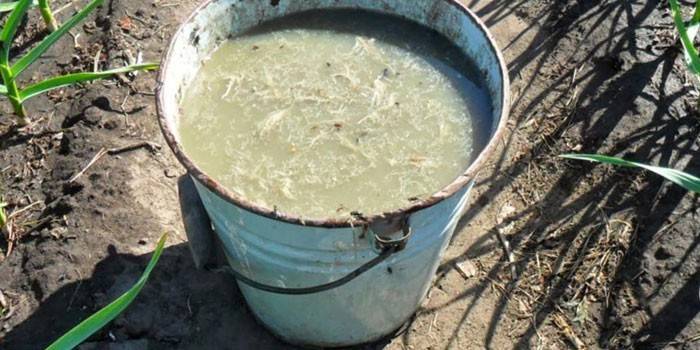

The number of dressings, their composition depends on the quality of the soil mixture. Primary feeding is carried out no earlier than 15 days after sowing and the appearance of full shoots. Before diving into open ground, peppers and tomatoes do not need early feeding, and after the procedure, you need to wait at least a week. A very good result is given by the alternation of mineral mixtures with organomineral ones. This top dressing is applied every 7-10 days. It is worth noting that an overabundance or lack of mineral nutrition has a bad effect on seedlings:
| Name | Oversupply symptoms | Treatment | Deficiency symptoms | Treatment |
| Nitrogen | Intensive growth of stems, leaves, the appearance of a rich green color, a decrease in disease resistance | Stop fertilizing with nitrogen, feeding with phosphorus-potassium agents | Decreased root development, stem growth | Add liquid nitrogen agent |
| Calcium | The appearance of chlorosis, a decrease in the absorption of iron | Feed with potassium or dolomite flour | Decreased stem growth, chlorosis, yellowing, leaf fall | Water 1-2 times a week with calcium nitrate (7-9 g per 3 liters of water) |
| Potassium | Growth retardation, lightening of leaves, appearance of spots and foliage falling | Feed with potash | The appearance of blueness on the leaves, spots, a brown tint around the edges, loss of immunity | Water with 1% nitrate once a week |
| Phosphorus | Rapid aging of plants, wilting of fruits, the appearance of chlorosis | Feed with phosphorus fertilizer | Poor plant growth, the appearance of red veins on the leaves | Insulate the windowsill, pour with azophoska solution (5g per 3l) |
How to feed tomato and pepper seedlings with ash at home?
Ash is not only an excellent source of potassium, calcium, magnesium and other minerals useful for plants, but also a unique substance that can make one from acidic soil that is suitable for vegetable crops. Ash in the soil reduces the risk of fungal diseases in tomatoes and peppers.
To prepare top dressing from ash, you need to mix one tablespoon of this substance with two liters of water and leave for a day. At the same time, you need to make sure that the ash that you use as fertilizer was not obtained from the incineration of construction waste and painted wood.
Fertilizers for feeding seedlings at home
At home, you can use any fertilizer. Price serves as a benchmark. Imported counterparts are usually more expensive, but they work the same way as domestic ones. Top dressing of tomato and pepper seedlings, as well as eggplants, zucchini, pumpkin will be cheaper if you buy good quality domestic fertilizers. This will increase the harvest and save money.
If you are engaged in the cultivation of poultry or cattle, then fertilizers will come by themselves. They can be used to make compost, which is very fond of young seedlings.
Another "home" available substance that strengthens plants during the period of active growth is wood ash obtained from burning leaves, branches, weeds.
Caution! Ash from waste and plastic incineration must not be used. It contains harmful substances that can harm both plants and human health.


How to dilute urea for feeding tomato and pepper seedlings?
Urea is a concentrated nitrogenous fertilizer. At the same time, the nitrogen in this substance is in a state convenient for the assimilation of plants. This fertilizer is in granular form. It can be applied both directly to the soil and as a solution.
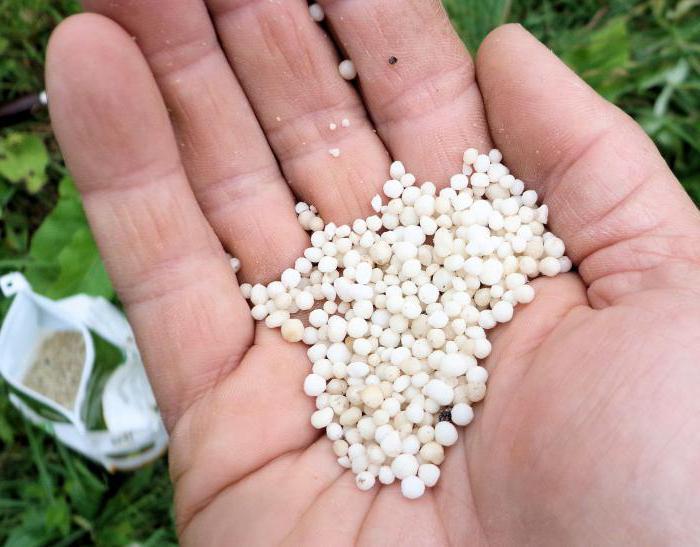

Urea
For root feeding with this fertilizer, 60 g of urea is diluted in water (10 liters) and watered with this solution of the plant. For foliar feeding, increased proportions are used (100 g of urea per 10 liters of water).
In dry form, urea is introduced into the ground at the rate of 12 g per 1 m2 before planting seedlings and 10 g per 1 m2 in the phase of active growth. You need to feed the seedlings with a liquid solution of urea before flowering.
Top dressing Krepish for tomato and pepper seedlings
"Krepysh" is a water-soluble fertilizer from. It is available in both dry and liquid form. This top dressing contains all natural stimulants, humates, necessary for vegetable crops, and such important elements for plants as:
- Magnesium
- Potassium
- Iron
- Nitrogen
The composition of this dressing is carefully balanced. This fertilizer is easy to work with. It is introduced into the soil with seedlings during watering. The first feeding must be carried out after the formation of the second leaf. Then, during a pick and every two weeks until the formation of flower ovaries.
For seedlings of peppers and tomatoes, it is necessary to dilute two teaspoons of "Krepysh" in 10 liters of water.
When to plant peppers and tomatoes for seedlings
Preparation for germination is carried out in the last days of February - early March. Then it should be planted in prepared cups. Depending on the climate of the region, varieties, planting dates can be changed. If the time is indicated on the package with seeds, then it is better to follow the recommendations. Tomato seeds are planted two weeks later than peppers. Pepper takes longer to rise.
Seeds are planted in a row with an interval of 1 cm. Sprayed and sprinkled with earth layer 5 - 7 mm, covered with plastic cling film and placed in a warm room. Temperature should be supported at 20 degrees.
In such conditions, seedlings appear in 3 - 5 days. For peppers, you need to wait for seedlings in 2 - 3 weeks. When leaves appear on the seedlings, you need to remove the film and put the plants in the light to stimulate the production of chlorophyll.
From this point on, you need to observe the seedlings. If tomatoes usually thrive on fertilized soil, then the peppers need more attention.
Top dressing for seedlings of tomatoes and peppers Ideal
Top dressing "Ideal" is created on the basis of biohumus (a product of the activity of earthworms). It can be used as a fertilizer for peppers, tomatoes and other fruit crops. Also, this dressing can be used for rooting cuttings and accelerated germination of seeds.
With the "Ideal" you can:
- Accelerate the adaptation of seedlings in a new place
- Improve the root and vegetative system of plants
- Accelerate fruit ripening
- Increase yields
- Increase the amount of nutrients in vegetables and fruits
- Reduce the risk of developing diseases in plants
Top dressing "Ideal" Is a Russian product. Domestic specialists, who took biohumus as a basis for this fertilizer, improved its structure by artificially introducing macro- and microelements that are necessary for cultivated plants.
Additive "Ideal" can be used as root and foliar dressing. For root dressing of tomato and tomato seedlings, use a solution of 8-12 ml of this product per 1 liter of water. This liquid fertilizer should be applied no more than once every 10 days.
For foliar dressing "Ideal" diluted in an amount of 5 ml per 1 liter of water. The solution is used to spray the leaves of the plant until the flowering phase.
First feeding
The need for nutrients in tomatoes and peppers appears after the formation of the second true leaf. Subsequently, fertilizers are applied every 10-15 days. At this time, it is important to avoid exceeding the norm of nutrients.
A generous watering with a copper solution provides plants with reliable protection against late blight. This substance can be found in any specialty store. To prepare a solution, 1 teaspoon of copper is diluted in 10 liters of pure water.The fertilizer remaining after watering can be stored in a plastic bottle until next year.
Top dressing of tomato and pepper seedlings with Epin
"Epin" Is a biostimulant, the task of which is to activate the processes that take place in plants and are necessary for their normal development. This medication is sold in an ampoule, the contents of which must be diluted with water.
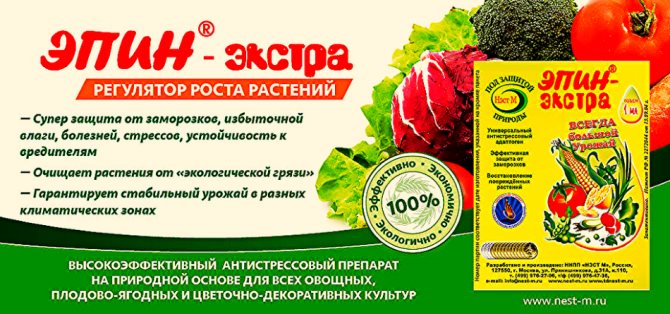

Epin
The greatest effect can be achieved if you use a solution "Epina" as a foliar dressing. For this purpose, it is necessary to dilute 5 drops of the biostimulant in 500 ml of warm water.
Use "Epin" it is possible after the formation of 3 true leaves in plants.
How to dilute nitroammofoska for feeding tomato and pepper seedlings?
Nitroammofoska is a top dressing containing all three of the most important elements for plant development: nitrogen, potassium and phosphorus. It is in the form of granules and can be used both dry (applied to the soil in bulk) and previously diluted with water. In liquid form, nitroammophoska is used when watering plants. But, it can also be used as a foliar dressing.
If there are not enough ovaries on your tomatoes, then with the help of such feeding, they can be increased. For this, the matchbox of nitroammophoska granules is diluted in a bucket of water. Under each bush of peppers or tomatoes, you need to add 500 ml of such a solution.
Nitroammofosk goes well with mullein, potassium sulfate and sodium humate.
Types of feeding
Most commercially available fertilizers are suitable for seedlings. When growing young seedlings on their own, the dosage should be halved, because the "adult" amount of nutrients for plants cannot be absorbed. It is better to adhere to the recommendations described in the instructions, which indicate the proportions for young plants and adults.
Caution! When buying fertilizers in a store, you should pay attention: if it is proposed to use the same doses of a substance for seedlings and adult plants, then the fertilizer is most likely not of high quality and it will not work. These products can be identified by their price - they are usually not high.
Manufacturers produce dry mixes and liquid fertilizers. In liquid form, nutrients are absorbed better and faster. To assimilate dry plants, you need to spend more energy to get them out of the soil.
There are conventional fertilizers and there is a chelated form. Conventional mixtures are assimilated by plants by 50% at best. Chelated - 90%. This also applies to the human body. Chelated ones are more expensive, since the production technology and the substances used are expensive. These are profitable investments, as they form healthy seedlings, which then develop well and bear fruit abundantly.
Important! You should not give young plants fertilizing based on sulfuric acid salts - sulfates. It is for seedlings that they are ineffective.
Organic fertilizers
Organic matter is a good fertilizer, but you need to know how to feed pepper and tomato seedlings so as not to harm them. For example - fresh manure should not be used for young peppers.
This substance contains a lot of ammonia, especially chicken droppings, which can burn roots. In this case, the plant dies. You must first insist and breed manure, and it is better to use rotted or composted.


If there are a lot of seedlings, then a third of a bucket of manure or chicken droppings is taken, filled with water and costs a week. It is necessary to stir periodically so that excess ammonia escapes into the atmosphere. Next, the resulting infusion is diluted: 10 liters of water are added to 1 liter. The rest of the substance is stored under a lid in a cool place. Chicken droppings insist the same but dilute 1 liter with 20 liters of water.
When growing tomatoes, you need to monitor the acidity of the soil.If the leaves have begun to wither, it is not always a matter of lack of nutrition. Perhaps tomato seedlings simply cannot assimilate it due to the low pH of the soil. It is increased with the help of wood ash containing phosphorus, potassium and almost the entire periodic table of trace elements.
Mineral fertilizers
From mineral mixtures, you can buy specialized, intended only for peppers or tomatoes, taking into account the needs of these crops. But ordinary universal ones are also suitable. The main thing is not to overdo it on dosages. The first rule of a successful gardener is to under-feed the plants rather than harm them.



